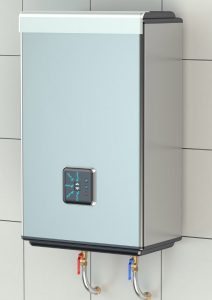How you vent your tankless water heater will depend on the model and where you want it to terminate. Things you may need:
Vent adapter Termination kit Pipes (PVC, ABS, or stainless steel) Pipe support and brackets
Typically, the venting Installation sequence is as follows:
Start by installing your water heater. Then, determine the termination method- sidewall or vertical, concentric or separate pipes, etc Determine the proper location for wall or roof penetration for each termination. Install terminator assembly Install air and vent piping from water heater to termination. Slope horizontal exhaust pipe downward towards the water heater a minimum of 1/4 inch per foot. Don’t slope combustion air pipe towards the unit. Ensure you dispose of condensate per local codes. Install pipe support and brackets every 4 feet to allow for movement from expansion as per your local code requirements.
Check this too: No Hot Water in Shower? Here is Why Termination Installation There are three venting termination configurations that can be used;
Concentric Termination-This allows for only one penetration through a wall or roof. Snorkel Termination- This allows for easier clearance above grade when having to terminate through a lower point. Sidewall Tee Termination
The type of termination required will depend on your unit and where you need to install it. A tee termination offers the best protection against wind and is recommended if the vent is terminated on a sidewall which is subject to high winds.
Tankless Water Heater Venting Kits
Depending on your scenario and where you need to install your water heater, here are some of the termination kits that you may need to finish the venting to the outside:
Two pipe layers Hood slopes down for draining condensate Seals at every joint Fits into other brands
Two ports, intake and exhaust Easy to install Fits other brands
Category III stainless steel Sloped hood UL approved non-corrosive Fits other brands
Works with condensing Integrated condensate collector Rain cap and storm collar 50-1 Pitched Cone Flashing
GSA approved Only works with noncondensing systems Fits into other brands Metal outer vent
Why Vent a Tankless Water Heater
All water heaters that burn gas require a venting system. The combustion process creates heat and some harmful exhaust gases. Tankless water heaters require a special venting to blow hot exhaust gas outside, where it dissipates. When venting non-condensing tankless water heaters, you need a metal like stainless steel or thick aluminum as the exhaust gas is hot. For condensing tankless water heater venting, you don’t need metal venting. Check this too: Reddy Heater Troubleshooting & How-to Guide
What Type of a Vent Does a Tankless Water Heater Use?
There are two ways to vent a tankless water heater, depending on your specific model:
Direct venting Power venting
Direct Venting
This type of vent draws air in from the outside and then vents the exhaust also. The advantage of this system is that it allows the unit to be placed in smaller spaces. Venting for this type of tankless water heater can be concentric or dual. A concentric vent kit has both the intake and exhaust on the same pipe. The exhaust is in the center so that the exterior of the vent doesn’t heat up. This makes it ideal since you can put the unit wherever you want as sealing it isn’t an issue. For dual vent systems you will have two pipes; one with the intake and one with the exhaust. Here the location matters as the exhaust pipe can get hot. The material is also a factor; typically these are made out of PVC as you can’t just seal stainless steel with silicone.
Power Venting
A power vent has the intake on the body of the tankless water heater and not through a vent or pipe. It uses the inside air to vent, with an exhaust leading out of the house. Since it needs a larger area for the air intake to vent properly, it can be limiting on the tank placement.
Do Propane Tankless Water Heaters Need to Be Heated?
Tankless water heaters fueled by propane have the same features as those that use natural gas. They heat the water only when it is needed. They don’t suffer standby heat loss as is the case with storage tanks. They use a flame so hot that you don’t need to keep water sitting in a storage tank. When you turn the hot-water faucet on, a sensor will activate a propane gas burner to heat the water.
Can a Water Heater be Vented Out through a Sidewall?
It is not necessary venting tankless water heaters through the roof. The vents in these units can terminate on a sidewall since their combustion fans blow exhaust horizontally, unlike storage tank water heaters that work through draft, allowing hot exhaust air to rise up and out of the facility.
Does an Electric Water Heater Need to Be Vented?
If you have problems with where to place your tankless water heater due to venting concerns, then you should consider getting an electric tankless water heater. These electric units don’t need to be vented and they have way more options than gas or propane units. GPM is the main issue with electric water heaters. They are typically better suited for point of use applications and in homes with smaller water demands. Check this too: How to Clean a Water Boiler and Remove Hard Water Build-Up
Can You Vent a Hot Water Heater with PVC Pipe?
You can use PVC or ABS as venting material for water heaters with power venting. These heaters come with an electric blower fan that cools the air and decreases the temperature of the exhaust going through the vent enough that it won’t compromise the vent. When doing the installations, check if they are permitted by the manufacturer and your local jurisdiction.
